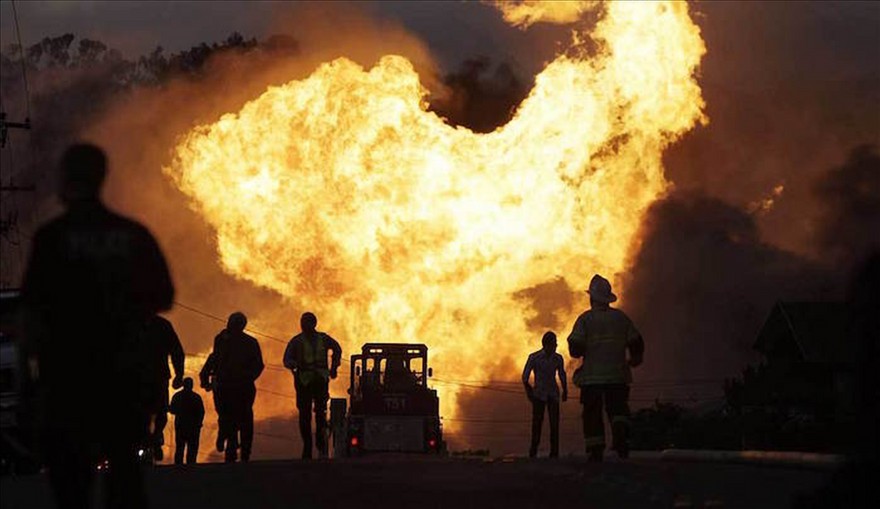Muslim “Refugee” With Gas Pipeline Plans Arrested in New Mexico Border County
 Police in a U.S. town bordering Mexico have apprehended an undocumented, Middle Eastern woman in possession of the region’s gas pipeline plans, law enforcement sources tell Judicial Watch. Authorities describe the woman as an “Islamic refugee” pulled over during a traffic stop by a deputy sheriff in Luna County, New Mexico which shares a 54-mile border with Mexico. County authorities alerted the U.S. Border Patrol and the Federal Bureau of Investigation’s (FBI) Joint Terrorism Task Forces (JTTF) has been deployed to the area to investigate, sources with firsthand knowledge of the probe confirm.
Police in a U.S. town bordering Mexico have apprehended an undocumented, Middle Eastern woman in possession of the region’s gas pipeline plans, law enforcement sources tell Judicial Watch. Authorities describe the woman as an “Islamic refugee” pulled over during a traffic stop by a deputy sheriff in Luna County, New Mexico which shares a 54-mile border with Mexico. County authorities alerted the U.S. Border Patrol and the Federal Bureau of Investigation’s (FBI) Joint Terrorism Task Forces (JTTF) has been deployed to the area to investigate, sources with firsthand knowledge of the probe confirm.
The gas pipeline plans in the woman’s possession include the Deming region, law enforcement sources say. Deming is a Luna County city situated about 35 miles north of the Mexican border and 60 miles west of Las Cruces. It has a population of about 15,000. Last year one local publication listed Deming No. 1 on a list of the “ten worst places” to live in New Mexico due to high unemployment, poverty, crime and a horrible public education system. The entire region is a High Intensity Drug Trafficking Area (HIDTA), according to the Justice Department’s National Drug Intelligence Center due to the large amounts of methamphetamines, heroin, cocaine and marijuana smuggled through the state by Mexican traffickers. Specifically, the renowned Juárez and Sinaloa cartels operate in the area, the feds affirm in a report.
Judicial Watch has broken a number of stories in the last few years about Mexican drug traffickers smuggling Islamic terrorists into the United States through the porous southern border. Last summer high-level sources on both sides of the Mexico-U.S. border offered alarming details about an operation in which cartels smuggle foreigners from countries with terrorist links into a small Texas rural town near El Paso. Classified as Special Interest Aliens (SIA) by the U.S. government, the foreigners get transported to stash areas in Acala, a rural crossroads located around 54 miles from El Paso on a state road – Highway 20. Once in the U.S., the SIAs wait for pick-up in the area’s sand hills just across Highway 20.
A few months ago Judicial Watch reported that members of a cell of Islamic terrorists stationed in Mexico cross into the U.S. to explore targets for future attacks with the help of Mexican drug traffickers. Among the jihadists that travel back and forth through the porous southern border is a Kuwaiti named Shaykh Mahmood Omar Khabir, an ISIS operative who lives in the Mexican state of Chihuahua not far from El Paso, Texas. Khabir trained hundreds of Al Qaeda fighters in Pakistan, Afghanistan and Yemen and has lived in Mexico for more than a year, according to Judicial Watch’s high-level Homeland Security sources. Now Khabir trains thousands of men—mostly Syrians and Yemenis—to fight in an ISIS base situated in the Mexico-U.S. border region near Ciudad Juárez. Khabir actually brags in a European newspaper article about how easy it is to stake out American targets because the border region is wide open. In the same story Foreign Affairs Secretary Claudia Ruiz, Mexico’s top diplomat, says she doesn’t understand why the Obama administration and the U.S. media are “culpably neglecting this phenomenon,” adding that “this new wave of fundamentalism could have nasty surprises in store for the United States.”
This recent New Mexico incident brings to mind a story Judicial Watch broke less than a year ago involving five young Middle Eastern men apprehended by Border Patrol in an Arizona town (Amado) situated about 30 miles from the Mexican border. Two of the Middle Eastern men were carrying stainless steel cylinders in backpacks, alarming Border Patrol officials enough to call the Department of Homeland Security (DHS) for backup. A multitude of federal agents descended on the property and the two men carrying the cylinders were believed to be taken into custody by the FBI. Only three of the men’s names were entered in the Border Patrol’s E3 reporting system, which is used by the agency to track apprehensions, detention hearings and removals of illegal immigrants. E3 also collects and transmits biographic and biometric data including fingerprints for identification and verification of individuals encountered at the border. The other two men were listed as “unknown subjects,” which is unheard of. “In all my years I’ve never seen that before,” a veteran federal law enforcement agent told Judicial Watch.
